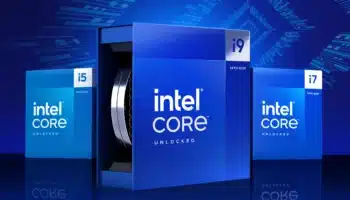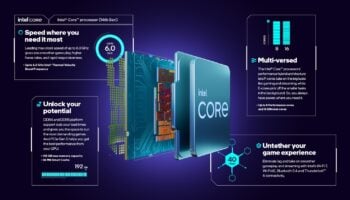AMD has launched what will likely be the final mainstream lineup based on the Zen 4 core architecture. The Ryzen 8000G processors (codenamed Phoenix) are the AM5 counterparts of the Ryzen 7000 mobile family. They feature less L3 cache than existing Zen 4 desktop chips, instead using that die space for a potent iGPU and an NPU unit that powers Ryzen AI technologies. All retail variants also have a boxed Wraith Spire/Stealth cooler and a TDP of 65W.
| SKU | Cores | Threads | iGPU | NPU | Z4 Clks Z4c Clks | Cache (L2+L3) | PCIe Lanes (Gen 4) | TDP | Price |
|---|---|---|---|---|---|---|---|---|---|
| Ryzen 7 8700G | 8 × Zen 4 | 16 | Radeon 780M (12CU, 2.9GHz) | XDNA 1.6GHz | 4.2/5.1GHz NA | 24MB | 20 | 65W | $329 |
| Ryzen 5 8600G | 6 × Zen 4 | 12 | Radeon 760M (8CU, 2.8GHz) | XDNA 1.6GHz | 4.3/5.0GHz NA | 22MB | 20 | 65W | $229 |
| Ryzen 5 8500G | 2 × Zen 4 4 × Zen4c | 12 | Radeon 740M (4CU, 2.8GHz) | NA | 3.5/5.0GHz 3.2/3.7GHz | 22MB | 14 | 65W | $179 |
| Ryzen 3 8300G | 1×Zen 4 3×Zen4c | 8 | Radeon 740M (4CU, 2.6GHz) | NA | 3.4/4.9GHz 3.2/3.6GHz | 12MB | 14 | 65W | OEM |
We’ll test the Ryzen 5 8600G on an MSI B650 Gaming WiFi and 32GB DDR5-6400 dual-channel (16GB x2) memory. The Fclk was set to 2400MHz and the controller clock was set to auto. Our review will consist of workstation benchmarks, productivity, and mainstream workloads. In the end, we’ll look at the iGPU gaming performance of the Radeon 760M without using an external graphics card.
Ryzen 5 8600G: Content Creation Performance
Cinebench is a reliable indicator of rendering performance. It scales well with core count and makes ample use of any extra threads (SMT or otherwise). The hex-core Ryzen 5 8600G does well for its stature but is no match for the existing Ryzen/Core champions.


Blender is another rendering workload that likes high thread counts without any of that hybrid core nonsense. The Ryzen 5 8600G is about a quarter as fast as the 7950X, which makes sense given their compute capabilities.

V-Ray is yet another rendering benchmark, one that doesn’t scale as well as Blender or Cinebench. In this case, the Ryzen 5 8600G delivers a third of the performance as the 7950X.

Corona 10 is a CPU ray-tracing benchmark. As with previous tests, thread count plays a vital role by increasing the number of rays cast (per second). The Ryzen 5 8600G outputs a modest 4319 rays/sec, down from 12504 rays on the 7950X.

Ryzen 5 8600G: Productivity and Essentials
The x265 (HEVC) codec is one of the best media codecs. Transcoding files to and from HEVC is a lengthy ordeal, even on the fastest consumer processors. The 8600G nets an average frame rate of 11 FPS versus 26 FPS on the 7950X.

7-zip and its LZMA compression algorithm are almost universal at this point. The Ryzen 5 8600G produces 96 GIPs and 86 GIPs during decompression and compression, respectively.

SPECWS RodininiaCFD is a product development workload part of the SPEC Workstation benchmark suite. The Ryzen 5 8600G scores 3.33 points, roughly half as much as the 7950X.

NAMD is a life-science benchmark that benefits from heavily threaded processors. The 8600G nets 2.56 points, a far cry from the 7+ points on other high-end chips.

FSI (Financial Services) runs the best on the Ryzen 9 7950X. The 8600G still produces a respectable 3.2 points, more than half as much as the Core i9-13900K.

Ryzen 5 8600G: Web Browsing
Jetstream and Kraken are tried and tested browser benchmarks. They benefit from bursty performance like most lightly threaded tests.

As you can see, core counts are less important here. High boost clocks and potent IPC lead the way in these tests. The Ryzen 5 8600G is only a smidge slower than the 7950X in these runs.

Ryzen 5 8600G: Radeon 760M iGPU Gaming
The Ryzen 5 8600G features the integrated Radeon 760M graphics processor. Based on the RDNA 3 architecture, it consists of 8 Compute Units (512 shaders) clocked at 2.8GHz (boost). Like most onboard GPUs, the memory bandwidth is your friend. Paired with DDR5-6400 dual-DIMM RAM, the 8600G produces fantastic results.

Even without AMD’s Fluid Motion Frame Generation technology, the Radeon 760M nets well over 60 FPS at 1080p “Low” using in-game FSR 2 across multiple popular titles. Cyberpunk 2077 averages 51 FPS, Shadow of the Tomb Raider 69 FPS, and Hitman 3 89 FPS on a system that costs just over $500.
Conclusion: Stellar Value and Potent Graphics
The Ryzen 5 8600G stands out as the most versatile processor in the sub-$300 niche. You get a capable hex-core CPU that’ll hold its own in most workloads and an iGPU on par with many lower-end discrete GPUs. Thanks to the high 8-lane PCIe 4 dGPU slot, you can pair it with a high-end graphics card for maximum gaming performance. For SFF enthusiasts, this APU is a much-awaited offering.
AMD Ryzen 5 8600G
CPU Performance - 8
iGPU Gaming Performance - 8
Power Efficiency - 8
Value for Money - 9
8.3
A true budget Gaming APU
The Ryzen 5 8600G stands out as the most versatile processor in the sub-$300 niche. You get a capable hex-core CPU that'll hold its own in most workloads and an iGPU on par with many lower-end discrete GPUs. Thanks to the high 8-lane PCIe 4 dGPU slot, you can pair it with a high-end graphics card for maximum gaming performance. For SFF enthusiasts, this APU is a much-awaited offering.






